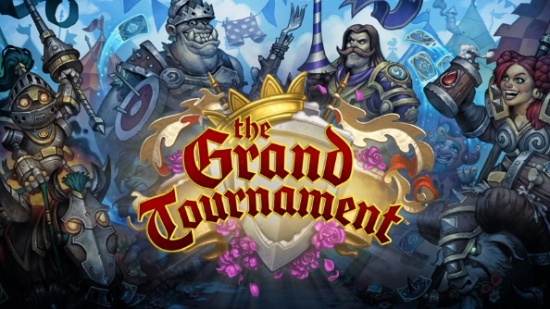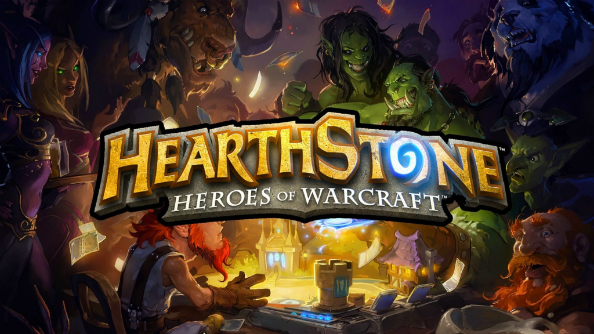Update 26/08/15: Our review of The Grand Tournament is here! See below for our impressions on the new cards and features, while our update discussion and original review are on page two and three respectively.
Hearthstone The Grand Tournament review
I love Hearthstone. But I hate recommending Hearthstone.
I didn’t realise I liked collectible card games. I didn’t understand why they were fun. But Blizzard’s version of a CCG – streamlined, fast, and funny – has hooked me.
Hearthstone is deceptively simple. Draw digital cards with funny pictures of gnomes on them. Place them according to a strict mana curve: with each turn allowing for more expensive cards to enter the arena. Choose to attack or defend. Repeat until dead.
Click play game. Repeat until the heat death of the universe.
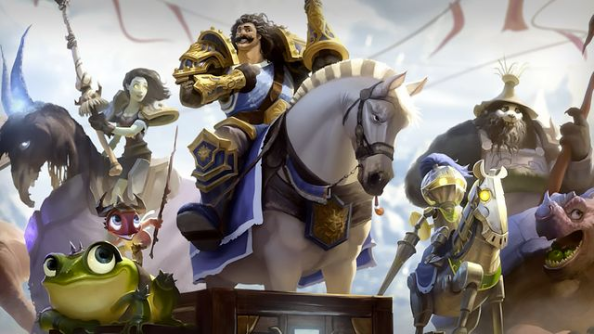
There are some clear reasons why it is so entertaining, and has gripped more people than other collectable card games. The strictly defined mana curve (the resource that defines what you’re able to play) is very easy to understand but provides every game with a clear point of escalation.
It understands that digital card games are not restricted to physical problems. The effects of certain cards would be difficult, if not impossible, to reproduce and track in a standard game. Cards like Grim Patron (replicates itself every time it survives an attack), Goblin Blastmage (randomly attacks other enemies), or Webspinner (when it dies it summons a random beast).
It feels alive. A Snowchugger doesn’t just stop an enemy from attacking: it encases them in ice for a turn. A Flamestrike doesn’t just remove some numbers from the cards it hits, it fills the board with flame. It is ultra-real: a magical board game delivered from a reality where turning goblins into sheep is a fairly regular occurrence.
It’s also mechanically brilliant. Hearthstone is one of the few games that embraces randomness. Many cards in Hearthstone depend on the luck of the dice. One of the most entertaining cards in the game is Flamewalker – which fires off random fireballs every time you cast a spell. The skill in playing Flamewalker is in which order you remove threats, so that your fireballs hit the targets you want. You don’t want to let RNG run its course: you want to manipulate the odds, stack the dice. Kill off those cheap cards with a single tap of your fireball so that the damage is concentrated on the opponent’s face.
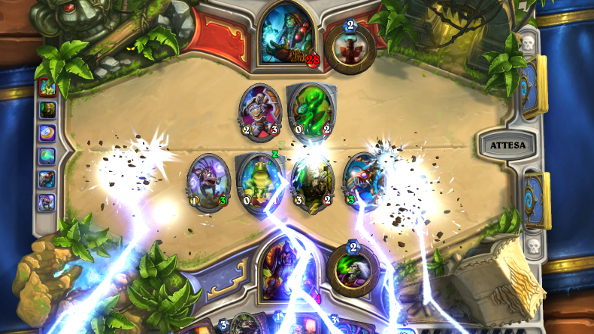
But Hearthstone is demanding, unfair, and occasionally brutal.
Your Hearthstone career will begin with a series of simple single player challenges: where you’ll fight various AI opponents earning the “Basic Set” of cards while learning the core mechanics of each class. Each of Hearthstone’s classes has their own play and deck style. Hunters usually aim to play aggressive low cost minions in the hope of finishing off opponents before they can create board presence. Priests are patient: countering threats until they can deliver massive minions and damage. Druids outpace their opponents, Warriors tank damage before deploying a wave of unstoppable enemies.
It’s those deck archetypes that will worry you.
Hearthstone is a ladder. And every rung climbed will cost you.
When I first started Hearthstone I tried to play it as cheaply as possible. I had a pretty good run with a Shaman deck that contained only Basic, free cards. It was competitive up to a certain point, but as soon as you graduate into the ladder proper, I found myself losing. Losing hard.
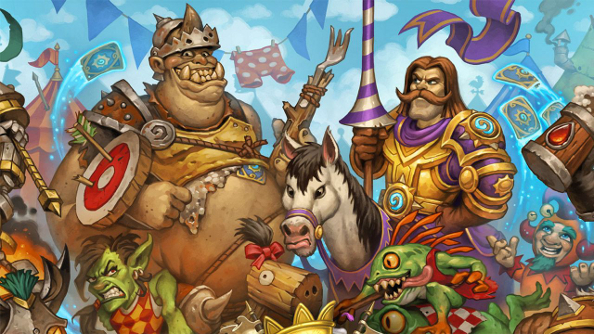
Hearthstone isn’t necessarily pay to win. You can earn gold and dust through completing daily quests, earning ranked rewards and disenchanting cards you don’t want. But that route is mostly theoretical. If you want to really compete, you have to suck it up and pay, buying bundles of packs or the adventure modes that release every six months. Getting up to speed as a new player today is ferociously hard unless you’re willing to chuck considerable cash at the game. And it’s not quite as simple as picking a deck you read about online and crafting the cards – you might need to buy specific adventure modes for specific cards before you can even think about crafting them.
At the time of writing, a new set of cards, The Grand Tournament, has launched. Right now, there’s no real sense of how these cards are going to shape or change the game. TGT brings in a few new mechanics: cards can be “inspired” by using your hero power, or you can “joust,” a way of comparing e-peon size, with the bigger minion earning bonuses. The two mechanics could theoretically slow down the game: there is a general feeling within the Hearthstone community that the game favours aggressive “fast” decks that overwhelm players who want to play more flavourful high end cards. I’m not sure that’s really true. At the levels I play at the only effect TGT has had on the game is to sub out some cheap minions for other cheap minions.
After spending the price of a full triple-A game on Steam, I’m still not able to create decks that I think will play well, just provide some small upgrades to what I already have.
And that’s why I love Hearthstone, but hate recommending Hearthstone. I think it’s an incredible game. It’s pervasive: I love that I can spend a few hours slumped in front of my PC playing, then transfer to an ipad to play casually while watching bad telly. I love being part of the community – browsing new deck ideas and ranting with friends about how overpowered Grim Patron really is.
But the cost of taking part is insane. For my fun over the past two years, I have paid around £200. That’s the kind of number that makes me wince. Hearthstone is the most expensive game I’ve ever played.
Hearthstone is good. I adore it. But think very carefully how if you want to get in here.
8/10
Check out page 2 to read what our impressions of Hearthstone were a year after launch, and page 3 for Nick’s original review of the base game.
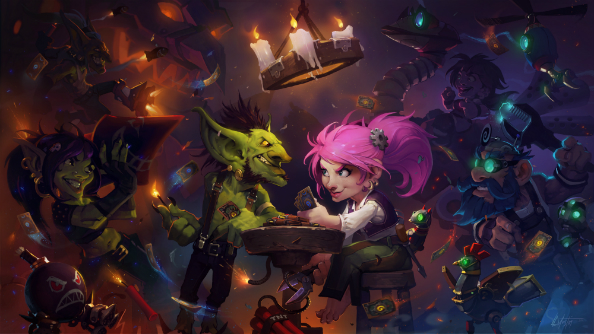
Hearthstone’s been out for a year. Are you still playing?
Nick: Absolutely. There are breaks from time to time, but that’s usually because I’m knee deep in some other Blizzard game *cough* WoW. Since launch it’s seen two major content releases: the Curse of Naxxramas adventure, and the Goblins versus Gnomes card expansion. Both have added great amounts of longevity to the game, as well as diversifying the card pool, allowing for even more deck concoctions.
Since I work at my PC throughout the day, I often found myself spending less and less time on Hearthstone, as I’d begin to favour games I could play from the comfort of my sofa or bed. Recently though, I’ve set up a simple joystick program that allows me to control Hearthstone with my Xbox pad. It’s heaven.
Tim: I’m back in, after a period of abstinence. All it took was a few YouTube videos of streamers pulling off ridiculous combinations and I fell immediately back in love after falling out with it around the time Naxxramas arrived. What I realised is that building competitive decks is never going to be my thing, and started looking at pre-mades on other sites. Now, I’m flying.
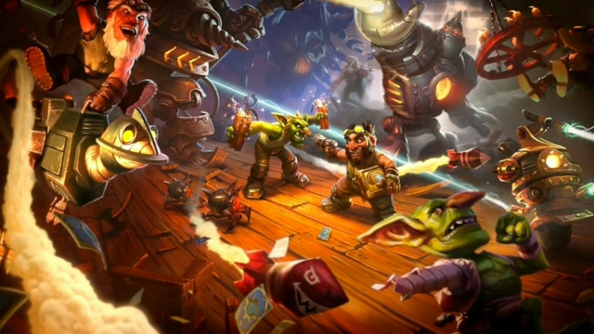
Back in the review, one of the reasons we didn’t give it a perfect score was that we were worried it was probably going to favour players that paid up. And they’d be paying up a lot. Have you spent much cash in it?
Nick: Full disclosure: I’ve spent quite a lot of money on Hearthstone. In the beginning, I easily laid down around £100 to give myself a healthy supply of cards to play with. Similarly, I did the same with Goblins vs Gnomes was released. Because I spend the gold I earn from daily quests on the arena, I didn’t have enough saved up for Curse of Naxxramas, and so bought the full adventure as well.
As an ex Magic: the Gathering player, dropping down a couple of hundred when I new set is released is quite the norm for me; I’ll admit that ‘cracking packs’ can be quite addictive. But for me, I like to play with a competitive edge, so it was my goal to have the majority of the cards unlocked to play with on the ranked ladder.
Tim: I bought Nax and a few packs to start with, but actually, I’m quite enjoying the challenge of ranking up by using decks entirely made from the basic and Nax sets. I feel a little bit at a disadvantage when other players are dropping annoy-o-trons left right and centre, but generally, even the basic cards can hold their own up to about level 15. In the meantime, I’m gradually expanding my collection with gold earned from quests and dust to craft cards I’ll get the most value from. I’ll almost certainly buy Blackrock Mountain when it arrives though.
Do you think Blizzard did a good job of balancing the original game?
Nick: The majority of the time, yes, but there has been some cards that were destined for a rebalance, and it took Blizzard an abnormally long time to finally cave in. I remember the Hunter deck with Unleash the Hounds and Leeroy Jenkins dominating play for months before they were nerfed. The development team certainly aren’t liberal when it comes to making changes to cards that dominate the meta.
Similarly, the dreaded Undertaker – used in another Hunter deck – proved to be an early game powerhouse that was too difficult to deal with. You would just mulligan at the start of each game until you have either one, or both of your Undertakers. It was the perfect ladder climbing deck – you win early and fast. Next.
Tim: What I find interesting about Hearthstone’s balance is how knife-edge it can be. Generally, if one card is over-powered, the result is that it reduces the range of decks that can be considered competitive. I think the balance problems we saw in the early game were probably as much to do with there not actually being that many cards available to choose from, as much as the cards themselves being OP.
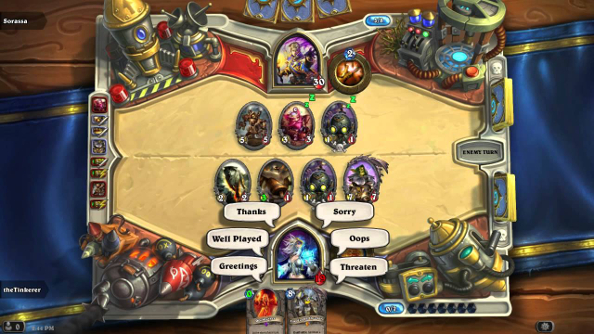
What about the expansions?
Nick: I still feel some cards from the Goblins versus Gnomes expansion need another look. You can barely find a single deck that doesn’t include a Dr. Boom somewhere in its list. It’s already is a 7/7 for seven mana – that alone makes it a great card. But then it floods the board with two Boom Bots that have the potential to deal up to eight damage to any target. You just can’t go wrong with this card.
Tim: Yeah, Dr. Boom is completely bananas. Like I said earlier, if you don’t have it in your deck, you’re being less competitive than a player that does. It just edges out other choices.
Did you enjoy the Naxxramas expansion?
Nick: It was lovely. I play World of Warcraft, and have very fond memories of the Naxxramas raid. There was a lot of personality injected into the adventure, and a few cracking good jokes. As for the bosses and challenges themselves, I think Blizzard hit the sweet spot in terms of difficulty. The first few times you go up against them, you’ll likely fail at least a couple of times before you finally make their portrait explode; just long enough to get your monies worth in terms of time spent.
But of course, then you have the heroic mode, which is downright torturous. These take extremely specific decks to overcome, and usually require use of the new cards from the adventure; sometimes from later bosses. It’s quite easy to just Google the best decks to use, but I found it much more satisfying brainstorming my own decks and winning my way.
Adventures are probably my favourite method of Blizzard adding in new cards to the game. Although they are dwarfed by the 100+ card expansion sets, they just have this charm which makes you feel warm and fuzzy inside. The former makes my wallet hurt, albeit at my own hand.
Tim: I loved it, loved doing each wing, and thought the class challenges were hilarious. I still get a bit of a giggle from the Hunter Webspinner only challenge. Just ridiculously fun design.
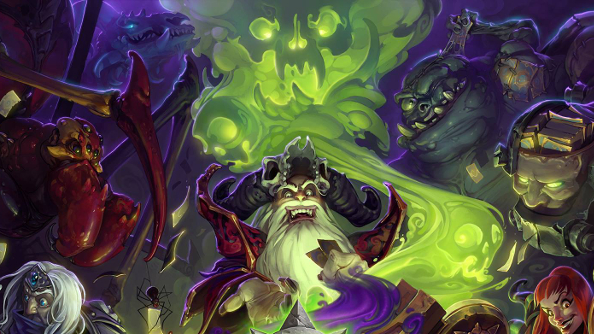
Goblins and Gnomes saw Blizzard doubling down on more randomised effects. What did you think?
Nick: This is a tough one to answer personally. Again, coming from Magic: the Gathering, there was indeed a bit of RNG involved, usually in the form of flipping a coin between two outcomes. But Hearthstone takes it much further than that, and more regularly too.
Goblins versus Gnomes saw three minions that could summon random X cost minions upon death; Sneed’s Old Shredder summoning a random legendary. These cards can be the pivotal moment of any game due to their random nature. If you want to see a perfect example of this, look at the below video.
It’s bonkers – true and utter chaos. But what’s important is that the opportunity for any such outcome is available to both players, but that outcome must remain strictly unaffected by their actions.
Do you still play Arena?
Nick: It’s what I spend all of my gold on that I get from daily quests. When compared to buying packs outright, it’s a no brainer in my opinion. Not only are you giving yourself potentially hours of fun, but if you do well, you can reap even more rewards than the gold you put in.
It’s also nice to play a mode where the manufactured meta doesn’t always apply. Drafting in arena is a fine art, that you learn over the course of many, many runs. Knowing what combos with what, which is the better card and giving yourself a good mana curve is crucial.
I do wish though that Blizzard implemented some other mode that offers similar rewards. A automatic drop-in tournament would be ace, similar to how the eSports format is currently done. It could have a buy-in to make it a gold sink of sorts, and there could be a tiered rewards system for where you placed in the tournament.
Tim: No. I’m aware it’s a much more efficient way of earning dust, but actually, I’d rather play ranked that screw around with building a deck in which I’m constantly questioning my own decision making. I’ve had a few Arena runs, but decided that it’s just not for me.
Hearthstone review
By Nick Wilson
There’s an elegance to Hearthstone.
It’s a fantasy collectible card game that feels simple and yet, when you dig into the mechanics, feels extraordinarily deep. It uses characters and artwork from World of Warcraft and transmogrifies them into little cards, making them fight with fizzles, crackles and pops.
I adore this game. It’s simple, fun and addictive: a truly astonishing feat considering the size of the development team. Thanks to an extended and open beta, there’s a good chance you’re already playing it. If not, allow me the pleasure of telling you why you should.
If you’re new to collectible card games, they can be daunting. Learning the ropes can drain the fun from playing. Hearthstone isn’t like that: you’re not going to find yourself grimacing when a exborbent rule book is dumped into your lap: because there isn’t one.
Instead what you have is mechanics that can be described in one sentence. Everyone has some mana. Cards cost mana. You have more mana every turn. Taunt cards ‘must be attacked first’. Stealth cards ‘cannot be targeted until they attack’.
Hearthstone doesn’t explain the mechanics: it shows. Taunts have big blocky shields. Stealth’s hide in a mist. Spells, like fireballs and arcane shots, fly across the board.
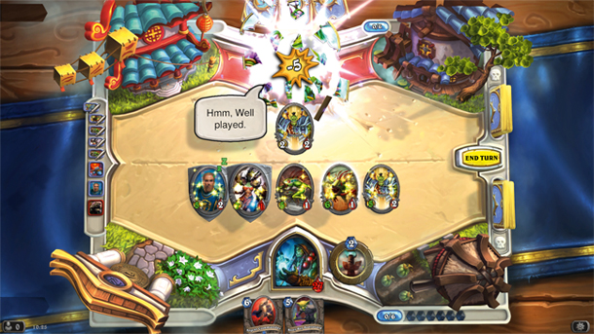
A match goes a like this. Both players start with 30 life and a deck of 30 cards. A coin flip determines the player who goes first, who draws three cards. The player that goes second gets to draw four cards, and that coin turns into a handy card: allowing you to add an extra mana to your pool for one turn. Mana is what you use to play your cards, and both players get one additional mana each turn up to a total of ten.
The first player to reduce their opponents health to zero, wins. The loser explodes.
You’ve got nine classes play with: represented by a character from the WoW lore all come with a ready made basic deck. What separates them from each other is their class specific cards and their hero power. Your classes hero power is a static ability which is always available to you. Shamans can summon signature totems, whereas a Priest can heal himself and his minions.
That’s all there is to it to get playing and having fun.
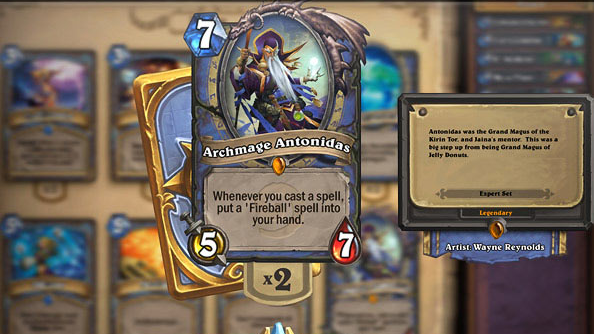
The depth is in the meta-game: the ever present process of building and improving your deck. Here players are free to pick from the cards they’ve earned or bought.
Deck ideas can be formed from just a few core cards and mechanics. For example: Warlocks can play powerful cards, cheaply, at the expense of their life. Add in Molten Giants – big damage dealers that cost less the more hurt you are, and you can see connections beginning to form. I’ve been experimenting with decks that prize spell power above all else, an overwhelming wave of murloc cards, and one deck that just utilises weapons. I’ve found that specialised decks, ones with a core concept, do better than those that just take a grab-bag of cards – but I haven’t found a deck that can crush all comers. That doesn’t mean I won’t stop trying.
The decks are meant to be played in ranked matchmaking: a multiplayer ladder that will take from rank 25, through to rank one. Reach level one, and you’ll earn titles and personalised card backs.
Multiplayer Hearthstone is endearing. The game makes a difficult choice early on: you’re not allowed to communicate with your opponent other than through a series of pre-selected emotes. That, in one swoop, does away with much of the toxicity that comes with online multiplayer. Hearthstone is better for it. Even the ‘threaten’ line, is solely in character. Players seem to appreciate the touch; most battles end with a “well played” or a “sorry” emote. If someone is a bit spam happy, you can satisfyingly ‘squish’ their emotes effectively silencing them.
At this point it’s worth bringing up how you earn and buy cards.
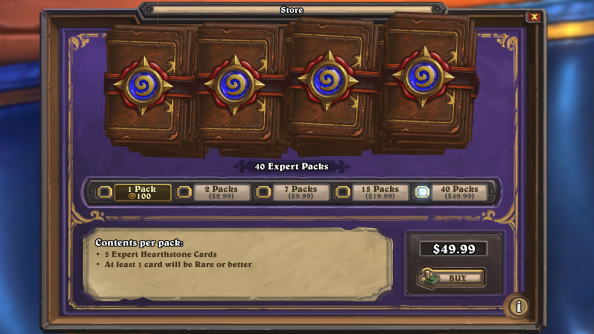
A basic set of cards is earned through levelling each character by playing in practice matches with an AI opponent – enough to show you the ropes. Everything else has to be bought using your own cash (approx $1.49/£1.00 per pack, with discounts for bulk purchases), gold earned from winning matches, or by destroying cards you own (like duplicates) to earn materials (arcane dust) that can be used to craft individual cards.
There will be accusations that Hearthstone is pay-to-win. That’s difficult to argue with. Some cards are unarguably more powerful than others. True too that if you’re looking for a natural, none-moneybags way to earn those cards, the rate at which you accumulate gold and arcane dust is slow.
Every card, depending on it’s rarity, has an associated dust cost. Golden cards: which are animated versions of their brethren, cost a premium amount. Dust is earned either through the arena, achievements or by disenchanting duplicates.
There are a lot of cards in Hearthstone: 465 in total that are playable, 382 which are collectible by the player. And a Hearthstone habit is hard to break.
Blizzard have made opening packs in this game as fun as cracking open the equivalent Magic: The Gathering boosters in real life. Maybe moreso: in real life, it’s rare that pack explodes open, and the cards are splayed facedown in front of you, waiting to be revealed. It’s rare too, that a cod-Scottish dwarf will proclaim your luck.
“Whoaa,” he screams. “A GOLDEN LEGENDARY!” Occasionally.
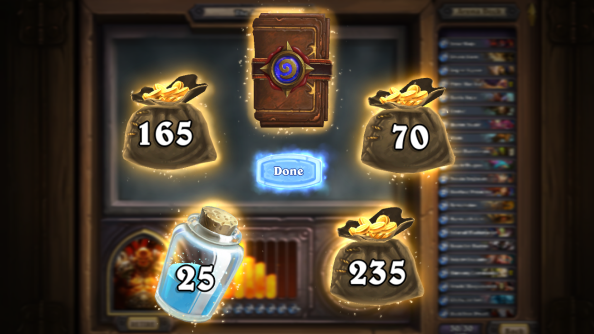
Confession time: I’ve probably spent just shy of £100 in Hearthstone: £80 on packs and £20 on arena entries.
For 150 gold, or $1.99/£1.49 you can roll the dice in Hearthstone’s hardcore mode. On entering the arena players are presented with three random hero classes, and then it’s time to draft a deck. While drafting you’re presented with a selection of three cards from a pool of your class specific and neutral cards. You’ll choose between rares, epics and even legendary cards if you’re lucky. Once you’ve got a deck of thirty cards, it’s off to battle.
The idea is to win as many matches as possible and avoid being eliminated by losing three matches. Your reward – represented by an upgrading key – is dependent on your final score. Get to around eight wins and you’ll make your gold back, and then some. Every reward no matter how bad is guaranteed a card pack, with other rewards including individual cards, golden cards and arcane dust.
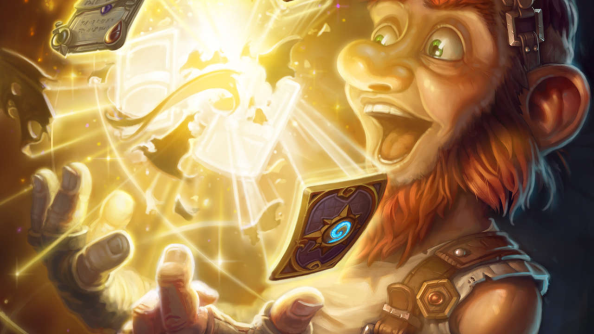
It always made sense to me to never spend my gold on raw packs of cards, and instead solely on the arena. It costs 50 gold more, but you only need to make that difference back in your winnings to break even in terms of value. It’s also another excuse to play, which is always good.
And that’s the real problem with Hearthstone. The game is spectacular: both welcoming and tactically devious, funny and friendly. But it makes me feel dangerously cosey. It’s very, very easy to spend money in this game, even if you have the option to take the longer route of unlocking things for free.
The feedback of your purchase is immediate, but short. It often than not leaves you wanting more. Daily quests give you random objectives that can be achieved with a couple of games, but the gold reward is slim. It will take at least two to three days of play to earn enough from them to enter the arena.
For a lot of us, that’s just not enough: further highlighting the allure of spending a bit of cash here and there. And it all adds up.
Hearthstone is a wonderful game. Nostalgic, simple and best of all: fun. This is the best online collectible card game you can play. Just be careful how much you spend in it.
